The much-awaited successor to the popular DJI Mavic Pro is here. Today we are excited to present to you our detailed and Hands-On DJI Mavic 2 Pro Review! DJI provided us with a pre-production unit for review. Read on to find out why the Mavic 2 Pro is The Ultimate Drone to own.
(Our Own Hands-On In Depth Review of the Mavic 2 Pro)
The Power of the Phantom 4 Pro in a compact package
How did the original Mavic Pro change consumer drones? The original Mavic Pro launched almost two years ago in September 2016. DJI took the Phantom 4 and crammed its features into the foldable and therefore compact Mavic Pro. Foldable props were in style. It was the first compact drone on the market with the combination of an excellent camera & 3-axis gimbal, great hard- and software. All was good. Yet, we wanted more. We started thinking up what-ifs, what if we could have a Sony RX100 style sensor on something that is smaller than an Inspire?
Bam! DJI released the Phantom 4 Pro (P4P). But that wasn’t enough of course. We got used to only carrying the Mavic Pro with us. One less bulky piece of luggage on road trips? Yes! Now the only option to have that level of quality in your footage and images was to carry around the P4P. The styrofoam cooler was back in the car.
Since the release of the P4P, the dream of having that huge 1″ sized sensor in a compact package, close to the size of the original Mavic Pro, was in peoples heads. Well, it’s no longer a dream, the DJI Mavic 2 Pro has arrived.
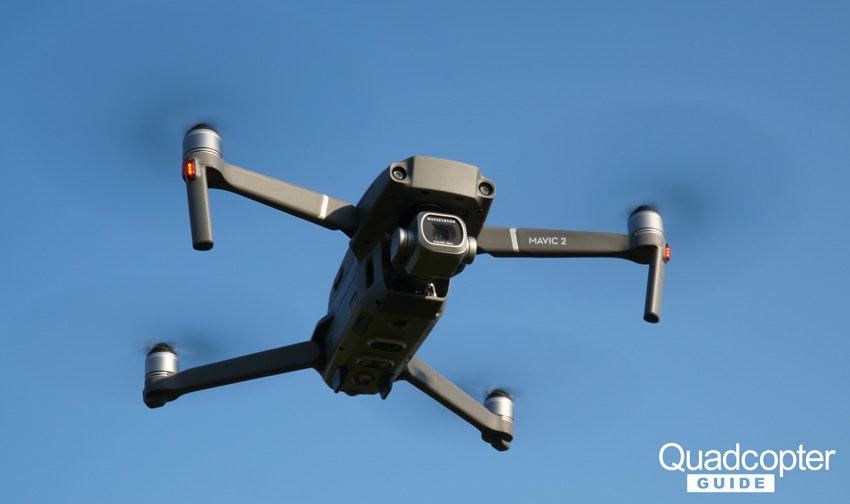 (The DJI Mavic 2 Pro and not Mavic Pro 2 as was initially rumored)
(The DJI Mavic 2 Pro and not Mavic Pro 2 as was initially rumored)
Our DJI Mavic 2 Pro Review
While there are several similarities to the original Mavic Pro, a few things immediately stand out when comparing its successor. We will discuss design, size, and features in a bit, but first the camera and what Hasselblad has to do with it.
Mavic 2 Pro Camera
Disclaimer and Information for photographs: The test flights took place in the Bavarian Alps in Germany! All images are jpg’s out of the DJI Mavic 2 Pro. WB set. Style Standard 0,0,0. Color Normal. Pre-Production Firmware (v1.00.00.00). Images are resized, watermarked and saved as 80% quality jpgs. The saturation is a bit high on the Standard Style setting. Sample images are available for download below.
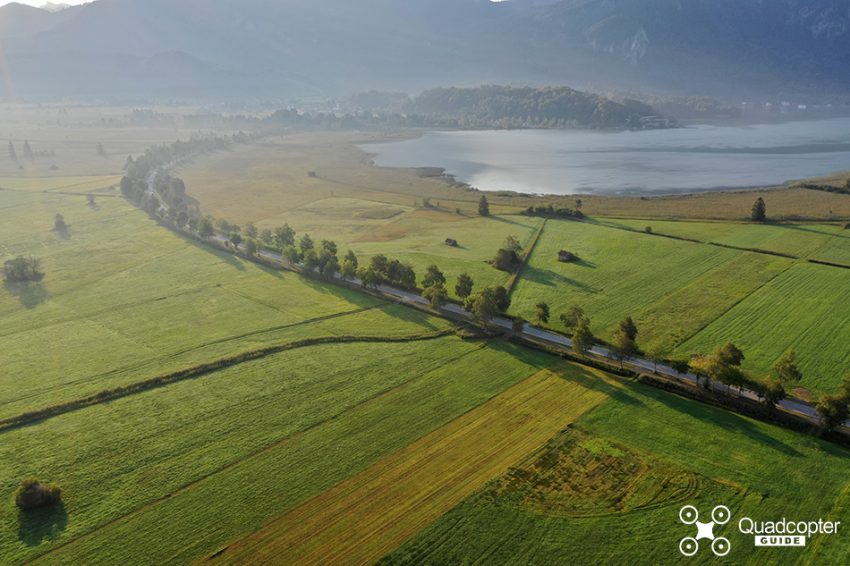 (Morning fog)
(Morning fog)
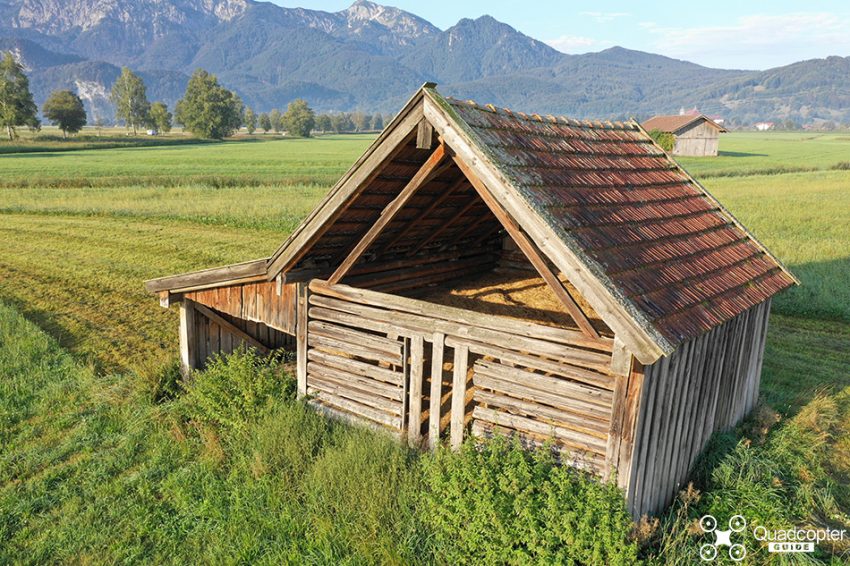 (Feed Storage)
(Feed Storage)
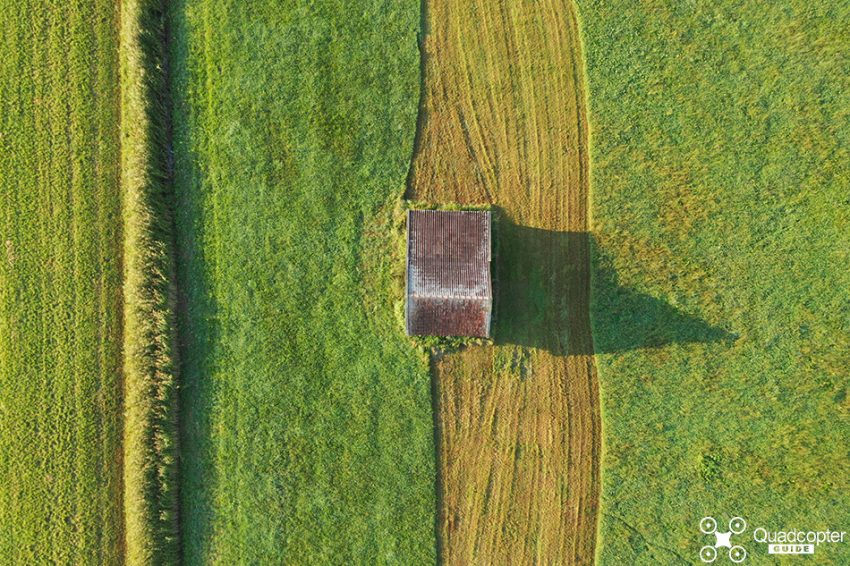 (The details in the full-sized images are incredible)
(The details in the full-sized images are incredible)

Camera Sensor
It wouldn’t be a proper DJI Mavic 2 Pro Review without diving into this primary feature. One of the most important aspects of a consumer/prosumer drone is its camera. The quality of the camera is mostly determined by the sensor size and quality of the lens in front of the sensor. The Mavic 2 Pro features a huge 1″ CMOS sensor housing 20 megapixels. This is the same size sensor featured in the much larger Phantom 4 Pro (& P4P V2.0) drones. The sensor is almost 4 times the size as the one featured in the Mavic Pro and Mavic Air.
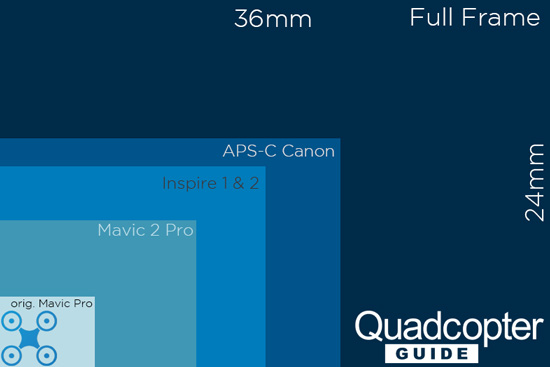 (Sensor size comparison Mavic 2 Pro vs Mavic Pro)
(Sensor size comparison Mavic 2 Pro vs Mavic Pro)
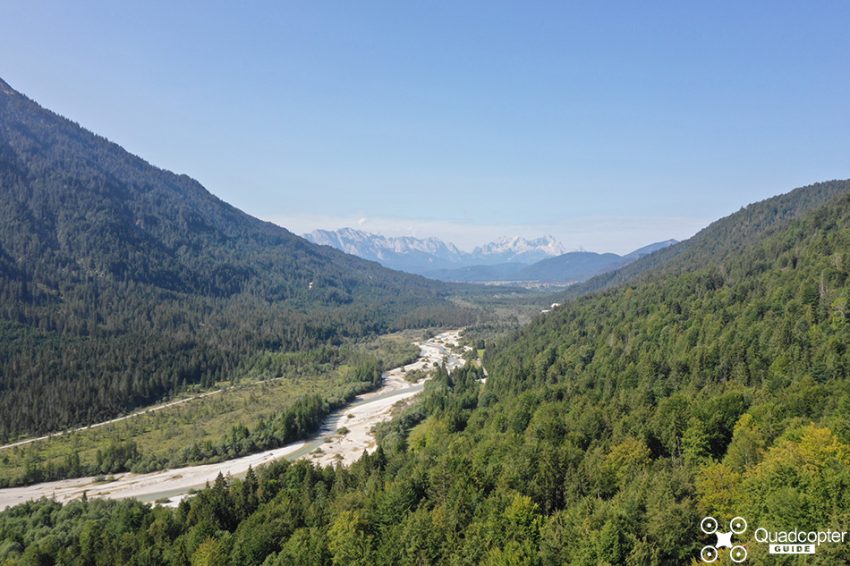
Hasselblad & HNCS
If you recall, DJI purchased a majority share of Swedish camera manufacturer Hasselblad at the beginning of 2017. This camera appears to be the first fruition of this partnership on a consumer level. On a professional level, DJI teamed up with Hasselblad to create this 100MP monster last year. The Mavic 2 Pro camera was co-engineered in partnership with Hasselblad. The team at Hasselblads HNCS (Hasselblad Natural Color Solution) were also involved in the design. The camera sensor delivers an impressive 14 stops of dynamic range. It has also been improved to minimize ghosting, motion blur, and other artifacts. A new Hyperlight mode promises improved images for large shutter speeds, especially for darker nighttime or dusk images. Hyperlight mode images will also have less noise in the photos. In the Exif information of the photos taken, Hasselblad is listed as device make and L1D-20c as the model.
Improved camera lens
The Mavic 2 Pro features adjustable Aperture settings from F2.8 to F11. The lens is 28mm (in 35mm equivalent) which covers a 77° FOV (Field of View). The focus distance range is 1 meter to infinity.
Part of our DJI Mavic 2 Pro Review, a special tip: You can yaw the camera left and right in the air, by just moving the gimbal. If you ever wanted to shoot off angle but still fly with the drone body perfectly straight. You now can do that. Tap and hold your smartphone’s screen and move your finger left and right. Perfect for taking pictures of the Mavic 2 Pro’s landing gear :).
The Phantom 4 Pro has some pretty noticeable lens flare at times. Upon inspecting our test images for the DJI Mavic 2 Pro Review, even taken directly into the sun, it appears much improved.
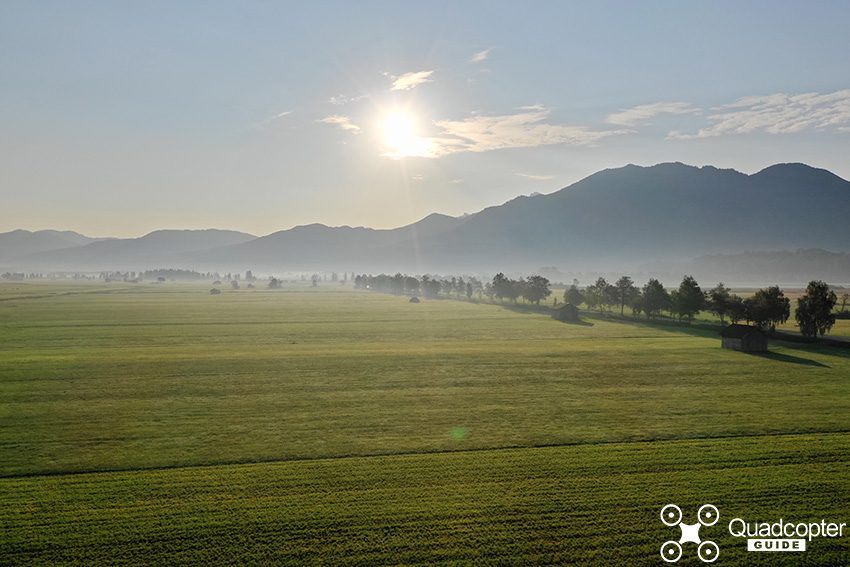 (Improved lens of the Mavic 2 Pro)
(Improved lens of the Mavic 2 Pro)
Surprises and other Features
Silence is golden
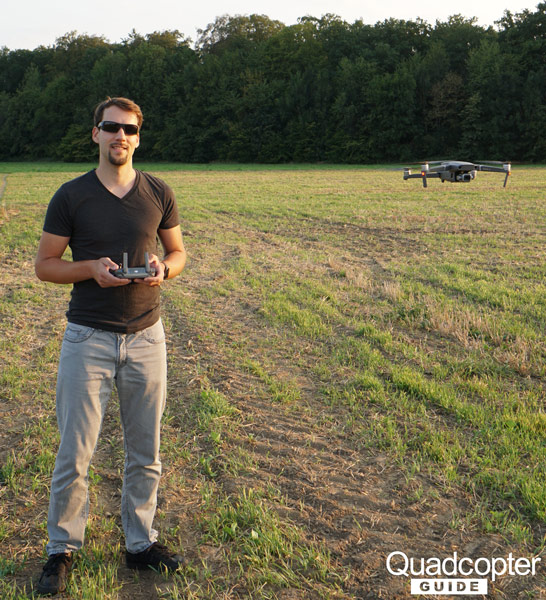 (The author with the Mavic 2 Pro on its maiden flight)
(The author with the Mavic 2 Pro on its maiden flight)
The first thing, you notice upon your maiden flight, “WOW, this thing is quiet!” Not silent, but quiet. Our maiden flight was at the edge of a farmer’s field with several walking paths near and through the field. For the first time, we felt that the noise coming from the drone wasn’t obnoxiously loud and you could hold a normal conversation with the drone being 20-30 feet (5-10 meters) away. The redesigned Sinusoidal drive architecture ESCs (Electronic Speed Controls) and the likewise redesigned low noise propellers are, we suspect, responsible for this.
Stability
Secondly, we realized why the Phantom 4 series drones such as the Phantom 4 Pro are more stable in the air than the now “old” Mavic Pro. It isn’t necessarily because of its large size, but more due to the increased weight. The Mavic 2 Pro (M2P) weighs in at 907 grams (2 lbs). This is a 24% increase over the 734 gram (1.62 lbs) Mavic Pro (MP). Its size hasn’t changed dramatically. Diagonally measuring the outside edges of the unfolded drone, we get an increase of only 1.9 cm (3/4 in). The drones body length increase by 0.8 cm and its height by 1 cm.
Motors and Propellers
Initially, we guessed that the motors felt a bit larger, in order to carry the larger camera and gimbal. To our surprise, the motor diameter is exactly the same as on the original Mavic. Exactly 24mm, we were curious and busted out our trusty caliper. The height of the motor did increase, however, most likely to increase the stator windings inside. The Mavic 2 Pro has 1.5mm taller motors (17.5mm). Furthermore, the top covers of the motors appear identical, the propellers appear backward and forwards compatible. Interestingly the propellers (type 8743F) are not the same as on the Mavic Pro Platinum (type 8331). The Mavic 2 Pro has an increased sport-mode top speed of 72 km/h (45 mph).
Efficiency and Power
Now we know what you are thinking, hmmm increased weight and size, this thing must burn through the battery rather quickly. Not So. Here the Mavic 2 also has advancements. In addition to more efficient ESCs and propellers, DJI is using a new 4S (4 Cell wired in Series) Lithium Polymer battery over the Mavic Pro’s 3S. The capacity or amount of energy capable of being stored in each cell grew insignificantly 20mAh (milliamp-hours) from 3830mAh to 3850mAh. Think of it as having another small gas tank added on. The new Mavic 2 battery does feel massive in one’s hand. Nevertheless, the advertised ~20% increase in flight time is noticeable.
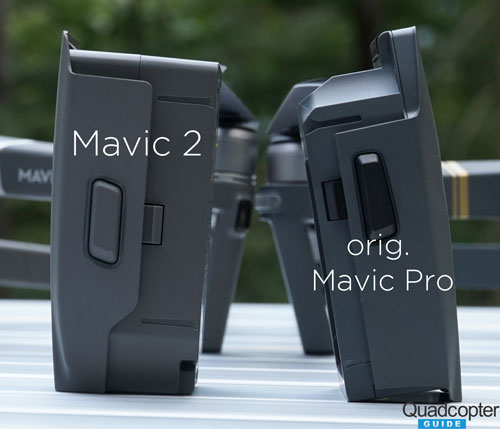
Not only have the Mavic 2’s flight abilities become more powerful. The transmission and communication system between the remote control and the Mavic 2 have improved. Read on to find out about the Mavic 2 Pro’s Occusync 2.0 implementation.
Obstacle Sensing and Avoidance
The Mavic 2 Pro features an improved APAS (Advanced Pilot Assistance System) as well as advanced omnidirectional obstacle avoidance. The Mavic 2 Pro now features sensors on all sides! The obstacle avoidance sensors on the sides are only available during Active-Track or Tripod Mode. Furthermore, there are two bright LED’s which can provide additional light, to improve bottom sensor accuracy in less-than-ideal situations. During our Active-Track (follow-me) test in a forest for our DJI Mavic 2 Pro Review, the Mavic 2 fared much better than the original Mavic. It successfully navigated around branches where the Mavic Pro went into a leaf-trimming mode. We will test this more thoroughly for our DJI Mavic 2 Pro Review video.
Photo and Video
The usual photo modes and features that you would expect are available. Detailed specs can be viewed here. The HDR algorithm has been reworked to provide less unwanted artifacts.
New Hyperlapse Mode
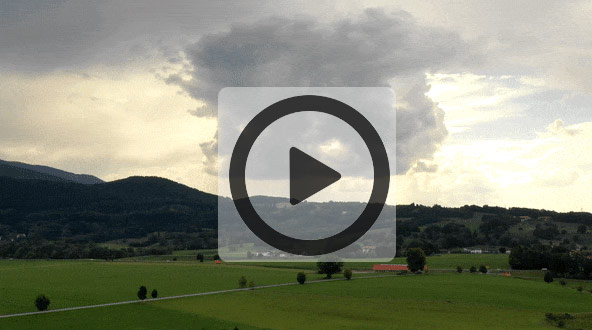 (Click the image above to view a Hyperlapse sample we recorded)
(Click the image above to view a Hyperlapse sample we recorded)
With this new intelligent flight mode, you have several ways to navigate while the drone takes individual photos and turns them into hyperlapses. You can circle a point of interest, follow waypoints, navigate freely or course-lock a heading. In the example above it took 3 minutes of flight time to create the 4-second hyperlapse. You can also save your Hyperlapse route into a new task library and refly existing routes at a later point in time.
Video
For the first time in a DJI prosumer drone, we get the ability to record in 10-bit. When you switch over to H.265 encoding, you are presented with the color modes HLG (HDR) and D-LOG. This is a nice feature for those wanting to squeeze every ounce of detail available to record out of the camera. We haven’t had a chance to test this yet in enough detail. Stay tuned. The usual 4K, 2.7K, 1080P, etc recording options are available. Recording bandwidth is 100mbps, same as the P4P.
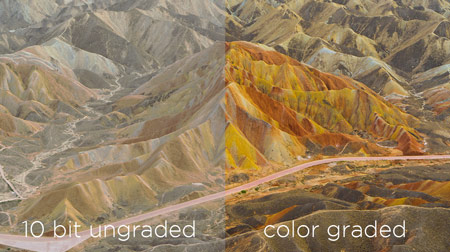 (Mavic 2 Pro 10 bit sample by DJI)
(Mavic 2 Pro 10 bit sample by DJI)
Remote Control
OcuSync 2.0
OcuSync 2.0 features improved interference resistance. For the first time, the Remote Control and the Drone can switch automatically between 2.4 & 5 GHz. Even with the big brother Phantom 4 Pro, you have to manually change frequency bands. For comparison, the Mavic Pro only uses the 2.4 GHz band. The upload and download bands could even be separated onto the 2.4 and 5 GHz bands if better suited for the current environment. The latency has been reduced to 120ms.
The improved OcuSync technology promises longer distance and higher resolution of transmission. Up to 8km distance at full 1080p quality. This means, the resolution streamed to your mobile device is good enough for a quick edit and upload of a video if needed. The Mavic 2 Pro is compatible with DJI Goggles “white” and Racing Edition.
Mavic 2 Pro & Mavic 2 Zoom
DJI also released a Mavic 2 Zoom, it shares many of the features of the Mavic 2 Pro, yet it has the same sized sensor as the original Mavic Pro. If you can swing the extra $200 we highly recommend getting the Mavic 2 Pro!
Pricing
The DJI Mavic 2 Pro starts at $1449! The Mavic 2 Pro Fly More Package including the Mavic 2 Pro, two extra batteries, and accessories (charging hub, power-bank adapter, car charger, Shoulder Bag, extra propellers) are available for $1768. The drones are in stock and the first batch is ready for shipment!
Video Review
Our Video DJI Mavic 2 Pro Review will be published on August 30th. Sign up in the email form below or subscribe on Youtube to be reminded of the DJI Mavic 2 Pro Review video!
Support our Blog! We’re just the small guys doing this drone stuff on the side. Support the content creation process by clicking on our links before purchasing your drone. Thank you!
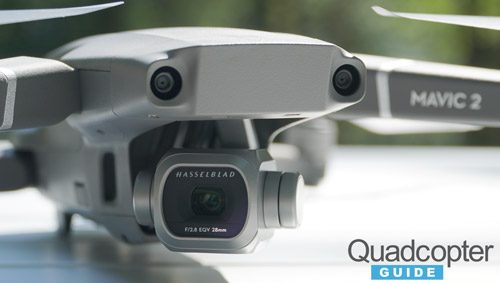







August 23, 2018
Is there Portrait mode, the feature present in the (first) Mavic Pro?
August 23, 2018
Hi Claudio, thanks for your comment. The Mavic 2 series gimbals do not turn 90 degrees as the original Mavic Pro did.
August 24, 2018
Your review is glowing but fails to mention the gimbal does NOT have the capability of shooting straight down due to the camera size/specs. Unlike nearly every other DJI camera drone. Additionally there is no discussion as to how much the 1″ sensor has been reconfigured for still images vs video. Is it the same sensor from the P4P or a completely redesigned sensor?
thank you
Jonathan Atkin nyc
August 27, 2018
Hi Jonathan,
Not sure where you got your information, but of course the Mavic 2 Pro also is able to film looking straight down. That is how we took the image above in the review of the Feed shed. We just fired up the Mavic 2 Pro and also on the test bench the camera points perfectly 90 degrees to the bottom.
The camera has been improved over the other DJI drones, here is a quote from Hasselblad:
“The Hasselblad L1D-20c, a state-of-the-art aerial camera, sets a higher standard for aerial image quality. With its powerful 20MP 1” sensor, it offers improved lowlight shooting capabilities in comparison to previous DJI drone cameras. Furthermore, with the Hasselblad Natural Colour Solution (HNCS), images are captured with the utmost colour accuracy”
Hope that helps!
September 10, 2018
Have you been able to further confirm that the D-Log footage in Full FOV mode is in fact 10bit in H265?
I read a comment from you that you’d tested it in VLC, I’m just wondering whether you have confirmed it in any other ways.
Thank you!
September 24, 2018
Hi Ben, thanks for your comment. Yes it records in 10bit in both Full FOV and HQ mode. Even Philip Bloom confirmed this recently.